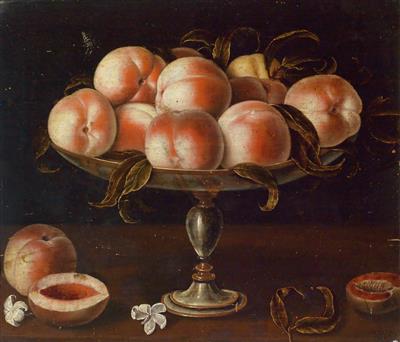Panfilo Nuvolone

(Cremona 1581–1651 Milan)
Fruit bowl with peaches,
oil on panel, 34 x 40 cm, framed
We are grateful to Alberto Cottino for confirming this to be a painting by Panfilo Nuvolone after inspecting the original.
The present painting has traditionally been attributed to Fede Galizia. Cottino, however, considers it a work by Panfilo Nuvolone, the other great master of the first phase of Lombard still life painting. Nuvolone is from Cremona, was probably already working in Milan before 1608 – and is still occasionally mistaken for Galizia. The present painting appears to be a variant of a composition Nuvolone painted at least twice (cf. L. Salerno, La natura morta in Italia 1560–1814, Rome 1984, p 64, ill. 16.3 and 16.4). The position of the bowl of peaches at the centre of the painting as well as the typology as a whole are almost identical although the present painting shows several important structural differences vis-à-vis the two paintings by Salerno: In the first the type and arrangement of the bowl are identical, though the bowl is of a different style and in place of the peaches are a brace of snipes. In the second painting, which is very similar to our painting, the two jasmine blossoms are missing and there are some differences in the proportions. While minimal, these differences make the present painting an autonomous work of art. It represents an important and to date unknown version of a theme that was obviously very popular among patrons in Milan. Panfilo Nuvolone and Fede Galizia generally liked to repeat their subjects based on models or drawings in their studio. Apart from still lifes, Nuvolone also painted altar pieces. His style is rooted in the Late Mannerism of Lombardy and the Po River plains, in particular inspired by the work of Camillo Procaccinis. His few, but very cleanly executed still lifes on the other hand occupy a true avant-garde position in his œuvre. Together with those by Fede Galizia, with which they are closely related in terms of style and depiction of nature, they are among the best Lombardy has to offer in the first decades of the 17th century.
We are grateful to Alberto Cottino for his assistance in cataloguing the painting.
21.04.2015 - 18:00
- Prezzo realizzato: **
-
EUR 45.000,-
- Stima:
-
EUR 25.000,- a EUR 30.000,-
Panfilo Nuvolone
(Cremona 1581–1651 Milan)
Fruit bowl with peaches,
oil on panel, 34 x 40 cm, framed
We are grateful to Alberto Cottino for confirming this to be a painting by Panfilo Nuvolone after inspecting the original.
The present painting has traditionally been attributed to Fede Galizia. Cottino, however, considers it a work by Panfilo Nuvolone, the other great master of the first phase of Lombard still life painting. Nuvolone is from Cremona, was probably already working in Milan before 1608 – and is still occasionally mistaken for Galizia. The present painting appears to be a variant of a composition Nuvolone painted at least twice (cf. L. Salerno, La natura morta in Italia 1560–1814, Rome 1984, p 64, ill. 16.3 and 16.4). The position of the bowl of peaches at the centre of the painting as well as the typology as a whole are almost identical although the present painting shows several important structural differences vis-à-vis the two paintings by Salerno: In the first the type and arrangement of the bowl are identical, though the bowl is of a different style and in place of the peaches are a brace of snipes. In the second painting, which is very similar to our painting, the two jasmine blossoms are missing and there are some differences in the proportions. While minimal, these differences make the present painting an autonomous work of art. It represents an important and to date unknown version of a theme that was obviously very popular among patrons in Milan. Panfilo Nuvolone and Fede Galizia generally liked to repeat their subjects based on models or drawings in their studio. Apart from still lifes, Nuvolone also painted altar pieces. His style is rooted in the Late Mannerism of Lombardy and the Po River plains, in particular inspired by the work of Camillo Procaccinis. His few, but very cleanly executed still lifes on the other hand occupy a true avant-garde position in his œuvre. Together with those by Fede Galizia, with which they are closely related in terms of style and depiction of nature, they are among the best Lombardy has to offer in the first decades of the 17th century.
We are grateful to Alberto Cottino for his assistance in cataloguing the painting.
|
Hotline dell'acquirente
lun-ven: 10.00 - 17.00
old.masters@dorotheum.at +43 1 515 60 403 |
| Asta: | Dipinti antichi |
| Tipo d'asta: | Asta in sala |
| Data: | 21.04.2015 - 18:00 |
| Luogo dell'asta: | Wien | Palais Dorotheum |
| Esposizione: | 11.04. - 21.04.2015 |
** Prezzo d’acquisto comprensivo dei diritti d’asta acquirente e IVA
Non è più possibile effettuare un ordine di acquisto su Internet. L'asta è in preparazione o è già stata eseguita.
